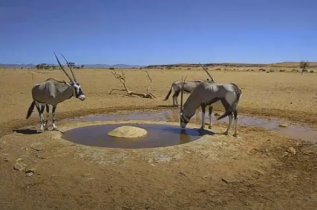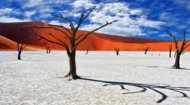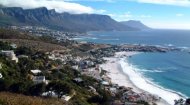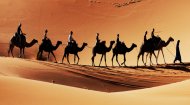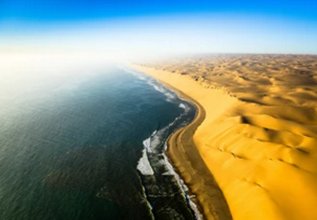|
Namib Desert |
Namib Desert |
Namib Desert | Namib Desert |

Namib Desert in NamibiaAnimals too have evolved remarkable traits. The fog-basking beetle stands on its head to allow condensed fog to roll down its body directly into its mouth. The Namaqua chameleon changes colour to regulate its body temperature. The sidewinder snake moves in a distinctive sideways motion to minimize contact with the hot sand. Larger mammals, such as the gemsbok (oryx), can survive for extended periods without drinking water, obtaining moisture from the plants they consume, while even desert-adapted elephants have learned to dig for water in dry riverbeds. Coastal areas host vast colonies of Cape fur seals, preyed upon by brown hyenas and black-backed jackals, showcasing the food chain's resilience even in this challenging environment. The northern part of the Namib, known as the Skeleton Coast, holds a particularly haunting allure. Its name derives from the numerous shipwrecks that litter its treacherous shores, visible reminders of the powerful Benguela Current and the dense fogs that confounded early navigators. Alongside the shipwrecks, whale and seal bones dot the landscape, adding to its eerie, desolate charm. Despite its forbidding nature, the Skeleton Coast is a significant wildlife haven, supporting unique populations of desert-adapted lions and brown hyenas, drawn by the plentiful seal colonies. For centuries, the Namib has been home to various indigenous groups, including the San people, who traversed its vastness with an intimate knowledge of its resources. In more recent times, human activity has largely revolved around mining, particularly for diamonds in the southern "Sperrgebiet" (Forbidden Area), and increasingly, tourism. However, most settlements are restricted to near Sososvlai, Walvis Bay and Swakopmund bordering on the desert. Recognizing the desert's global ecological and geological significance, large portions of the Namib have been designated as protected areas. The Namib-Naukluft National Park, one of the largest conservation areas in Africa, encompasses a vast stretch of the desert, safeguarding its unique ecosystems. In 2013, the Namib Sand Sea was declared a UNESCO World Heritage Site, acknowledging its outstanding universal value as the only coastal desert in the world that includes extensive dune fields influenced by fog. However, challenges remain. Balancing the demands of mining and tourism with the need to protect fragile ecosystems requires careful management and sustainable practices. Visiting the Namib Desert is an unparalleled experience that offers profound solitude and a deep connection with nature. Whether climbing the towering dunes of Sossusvlei at sunrise, hot air ballooning over the vast wilderness, exploring the stark beauty of the Skeleton Coast, or simply witnessing the incredible adaptations of its wildlife, the Namib leaves an indelible mark. It is a place that whispers tales of ancient Earth, of relentless winds, and of life's extraordinary will to endure, reminding us of the planet's enduring mysteries and its awe-inspiring power. |
